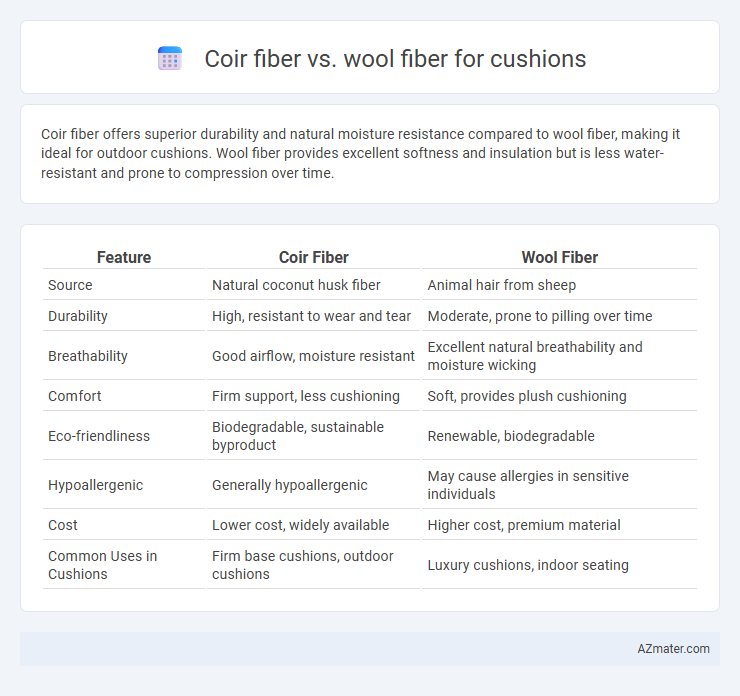Coir fiber offers superior durability and natural moisture resistance compared to wool fiber, making it ideal for outdoor cushions. Wool fiber provides excellent softness and insulation but is less water-resistant and prone to compression over time.
Table of Comparison
| Feature | Coir Fiber | Wool Fiber |
|---|---|---|
| Source | Natural coconut husk fiber | Animal hair from sheep |
| Durability | High, resistant to wear and tear | Moderate, prone to pilling over time |
| Breathability | Good airflow, moisture resistant | Excellent natural breathability and moisture wicking |
| Comfort | Firm support, less cushioning | Soft, provides plush cushioning |
| Eco-friendliness | Biodegradable, sustainable byproduct | Renewable, biodegradable |
| Hypoallergenic | Generally hypoallergenic | May cause allergies in sensitive individuals |
| Cost | Lower cost, widely available | Higher cost, premium material |
| Common Uses in Cushions | Firm base cushions, outdoor cushions | Luxury cushions, indoor seating |
Introduction to Coir Fiber and Wool Fiber
Coir fiber, derived from the outer husk of coconut shells, is known for its durability, natural water resistance, and firm texture, making it ideal for eco-friendly cushions that require firmness and breathability. Wool fiber, obtained from sheep fleece, offers remarkable softness, insulation properties, and moisture-wicking abilities, providing luxurious comfort and temperature regulation in cushions. Both fibers represent sustainable choices with distinct tactile and functional benefits suited to different cushion preferences.
Source and Sustainability of Coir vs Wool
Coir fiber, derived from the outer husk of coconut shells, is a renewable and biodegradable material sourced primarily from tropical regions with abundant coconut plantations. Wool fiber comes from the fleece of sheep, requiring significant land, water, and feed resources, though it is also biodegradable and renewable. Coir's sustainability advantage lies in its use of agricultural byproducts and lower environmental impact compared to wool's intensive livestock farming and methane emissions.
Physical Properties Comparison
Coir fiber exhibits high durability, natural water resistance, and coarse texture, making it ideal for firm cushions with good ventilation and moisture control. Wool fiber offers superior softness, elasticity, and excellent insulation properties, ensuring comfort and warmth in cushioned applications. While coir is more rigid and breathable, wool provides softness and thermal regulation, catering to different cushioning needs based on physical fiber characteristics.
Comfort and Cushion Support
Coir fiber provides firm, resilient cushion support due to its natural stiffness and breathability, making it ideal for maintaining shape over time and offering moderate comfort with good ventilation. Wool fiber excels in softness and elasticity, offering superior comfort through its natural cushioning and temperature regulation properties, while providing gentle support that adapts to body contours. When prioritizing durability and structured support, coir fiber is preferable, whereas wool fiber is better suited for plush comfort and luxurious softness in cushions.
Durability and Lifespan
Coir fiber for cushions offers superior durability due to its natural resistance to compression and moisture, maintaining firmness for up to 10-15 years with minimal degradation. Wool fiber cushions, while softer and more breathable, have a shorter lifespan of approximately 5-7 years because of fiber breakage and susceptibility to pests and mildew. Coir's robust structure provides long-term support and resilience, making it a preferable option for cushions requiring extended use.
Moisture and Allergen Resistance
Coir fiber exhibits superior moisture resistance due to its natural ability to wick away water, preventing mold and mildew growth, making it ideal for cushions in humid environments. Wool fiber also excels in moisture management by absorbing up to 30% of its weight in moisture without feeling damp, while offering excellent allergen resistance through natural lanolin content that repels dust mites. Choosing coir enhances durability and moisture control, whereas wool provides a softer feel with enhanced hypoallergenic properties for sensitive users.
Eco-Friendliness and Biodegradability
Coir fiber, derived from coconut husks, is highly eco-friendly due to its natural renewable source and minimal processing requirements compared to wool fiber, which comes from sheep and requires resource-intensive animal farming. Both coir and wool fibers are biodegradable, but coir decomposes slower, providing longer durability in cushions while reducing environmental impact. Wool fiber offers excellent biodegradability and natural flame resistance but has a higher carbon footprint from livestock emissions, making coir a more sustainable choice for eco-conscious cushioning.
Maintenance and Cleaning
Coir fiber cushions require minimal maintenance, as they resist mold and mildew and can be easily aired to remove moisture and odors. Wool fiber cushions demand more care, including regular vacuuming and occasional dry cleaning to prevent matting and maintain softness. Coir's natural durability offers practical advantages for low-maintenance use, whereas wool provides superior comfort with higher upkeep.
Cost Considerations
Coir fiber is generally more cost-effective than wool fiber for cushions, offering a natural, durable option at a lower price point due to its abundant availability and simpler processing methods. Wool fiber, while more expensive, provides superior softness and insulation, making it a premium choice for high-end cushions. The cost difference between coir and wool fibers significantly impacts overall production expenses, with coir being preferred for budget-friendly cushions and wool favored for luxury comfort.
Best Use Cases for Cushions
Coir fiber is ideal for outdoor cushions and heavy-use furniture due to its durability, water resistance, and natural firmness, providing excellent support and ventilation. Wool fiber is preferred for indoor cushions where softness, warmth, and moisture-wicking properties enhance comfort and insulation. Choosing coir extends cushion longevity in humid or rough environments, while wool offers a plush, cozy feel suited for living rooms and bedrooms.

Infographic: Coir fiber vs Wool fiber for Cushion
 azmater.com
azmater.com